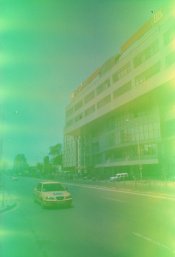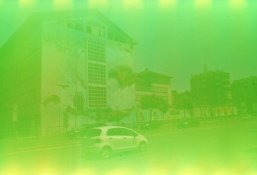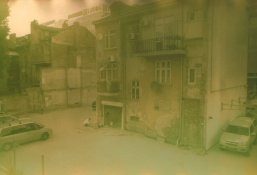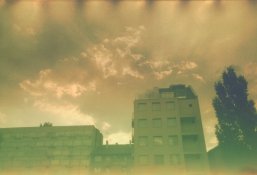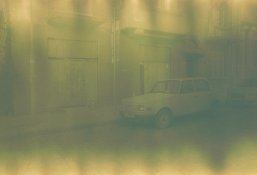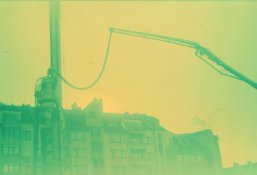Hi, Guys,
I've been souping my slide film in diluted C-41 chemistry at home, getting good results with fresh film and developer, but got a few nasty surprises with old developer and/or old transparencies.
My question is about some old ORWO transparencies I got cheap locally. UT-18, UT-21, UK-17 are supposed to be developed with a special process, whose components don't seem to be available nowadays. I've already tried to soup quite a few, but never got a scannable image. My last roll (UK-17, ASA40, expired decades ago) was exposed as ASA6(!), then souped in 1+100 Rodinal (yeah, that's the B&W developer I trust so far) and had decent B&W negative exposures after stopping and washing.
I put out the film, exposed it properly against the lamp and left it drying for a while in order to be spooled and colour-developed next.
After a good wash, the film was souped in diluted RA-4 chemistry. The exact dilution is unknown, but the stuff is still stinking and was able to darken the spooled film for maybe two minutes. I left it there until the frame spaces became almost invisible, but not more since I didn't want to have too dense transparencies (LOL).
After stopping in very weak citric acid, and washing for a few minutes, I bleached with C-41 bleach and the film from almost black turned orange (I had it spooled with the emulsion out to visually monitor the process).
Now comes the fun part - after pouring the fixer in (not fresh A-300 by ORWO), the film from orange turned almost black! Since the anti-haliation layer was still there after bleaching, I don't know if the bleach or the fix ruined it. Now there is almost no recognizable frame on the film, only the most over-exposed areas of the photos having a distinctive reversal image.
I did a cross-process and used the same bleach and fix a few days ago on two fresh rolls of Elitechrome 100, and got no fog at all, just great x-pro negatives, of the crazy saturation and contrast that I adore, so should I conclude that my initial B&W development was highly insufficient and that is why I got unrecognizable images at the end?
The density after the first dev was in my opinion "acceptable" as a B&W negative, but does it have to be much denser in order to be able to remove the silver slat that the second developer will "see"?
I've been souping my slide film in diluted C-41 chemistry at home, getting good results with fresh film and developer, but got a few nasty surprises with old developer and/or old transparencies.
My question is about some old ORWO transparencies I got cheap locally. UT-18, UT-21, UK-17 are supposed to be developed with a special process, whose components don't seem to be available nowadays. I've already tried to soup quite a few, but never got a scannable image. My last roll (UK-17, ASA40, expired decades ago) was exposed as ASA6(!), then souped in 1+100 Rodinal (yeah, that's the B&W developer I trust so far) and had decent B&W negative exposures after stopping and washing.
I put out the film, exposed it properly against the lamp and left it drying for a while in order to be spooled and colour-developed next.
After a good wash, the film was souped in diluted RA-4 chemistry. The exact dilution is unknown, but the stuff is still stinking and was able to darken the spooled film for maybe two minutes. I left it there until the frame spaces became almost invisible, but not more since I didn't want to have too dense transparencies (LOL).
After stopping in very weak citric acid, and washing for a few minutes, I bleached with C-41 bleach and the film from almost black turned orange (I had it spooled with the emulsion out to visually monitor the process).
Now comes the fun part - after pouring the fixer in (not fresh A-300 by ORWO), the film from orange turned almost black! Since the anti-haliation layer was still there after bleaching, I don't know if the bleach or the fix ruined it. Now there is almost no recognizable frame on the film, only the most over-exposed areas of the photos having a distinctive reversal image.
I did a cross-process and used the same bleach and fix a few days ago on two fresh rolls of Elitechrome 100, and got no fog at all, just great x-pro negatives, of the crazy saturation and contrast that I adore, so should I conclude that my initial B&W development was highly insufficient and that is why I got unrecognizable images at the end?
The density after the first dev was in my opinion "acceptable" as a B&W negative, but does it have to be much denser in order to be able to remove the silver slat that the second developer will "see"?











